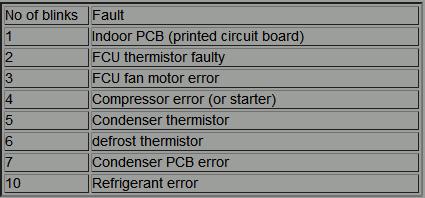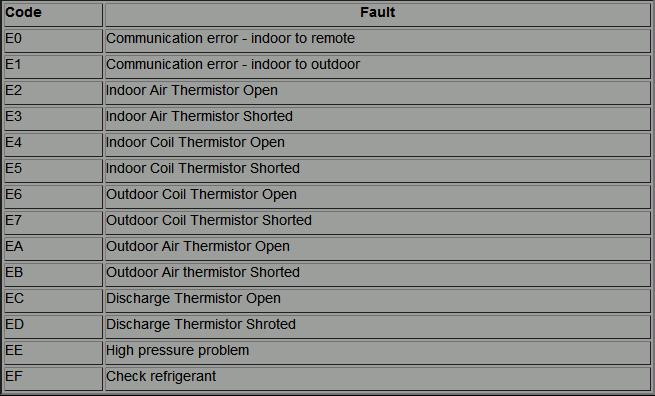Aircon Blinking Lights and their Malfunction Codes
Disclaimer:
These error codes are provided based on the best of our knowledge, the same set of error codes may differ
depending on the models. We are not liable for any mistakes in the malfunction codes:
source is from : http://www.astiquer.com
When your "timer" light blinks, it is not that your timer is faulty. Most manufacturer uses any of the LED lights blinking to
indicate a faulty air conditioning system.
"Inverter" air conditioner is more powerful when in comes to error code, because the indoor unit and outdoor unit were
already linked up and communicating, a non-inverter condenser simply accepts a 230vac voltage to start turning the
compressor and fan, so the indoor and outdoor is not really "communicating".
DAIKIN error codes:
AO Indoor Error of external protection device
A1 Indoor PCB defect
A3 Indoor Malfunction of drain Level control system
A5 Indoor Freeze-up prevention
A6 Indoor Fan motor lock, Overload
A7 Indoor Malfunction of swing motor flap
A9 Indoor Malfunction of EEV
AF Indoor Drain level above limit (clogging)
AJ Indoor Malfunction of capacity set device
C3 Indoor Malfunction of drain thermistor
C4 Indoor Malfunction of liquid pipe thermistor
C5 Indoor Malfunction of gas pipe thermistor
C7 Indoor Lower louvre limit switch/motor
C9 Indoor Malfunction of air thermistor
CC Indoor Malfunction of moisture sensor
CA Indoor Malfunction of discharge air thermistor
CJ Indoor Malfunction of remote control thermistor
CE Indoor Malfunction of radiant heat sensor
E0 Outdoor Activation of outdoor safety device
E1 Outdoor PCB defect
E3 Outdoor Activation of high pressure switch
E4 Outdoor Activation of low pressure switch
E5 Outdoor Activation of compressor over heat protection
E5 Outdoor Compressor motor lock
E6 Outdoor Compressor start up error
E6 Outdoor Standard compressor lock/overcurrent
E7 Outdoor Fan motor lock, Overload
E8 Outdoor Inverter input overcurrent
E9 Outdoor Malfunction of EEV
EA Outdoor Four way valve defective.
F3 Outdoor Abnormal discharge pipe temperature
F6 Outdoor Refrigerant overcharged
FC Outdoor Low pressure drop.
H3 Outdoor High pressure switch defect
H4 Outdoor Low pressure switch defect
H6 Outdoor Compressor motor position detection sensor error
H7 Outdoor Fan motor position detection sensor error
H8 Outdoor Current transformer error
H9 Outdoor Malfunction of air thermistor
J1 Outdoor Malfunction of pressure sensor
J2 Outdoor Current sensor malfunction
J3 Outdoor Malfunction of discharge pipe thermistor
J4 Outdoor Low pressure saturation thermistor
J5 Outdoor Malfunction of suction pipe thermistor
J6 Outdoor Malfunction of heat exchanger thermistor
J7 Outdoor Malfunction of heat exchanger liquid thermistor
J8 Outdoor Malfunction of liquid pipe thermistor
J9 Outdoor Malfunction of gas pipe thermistor
JA Outdoor Malfunction of discharge pipe pressure sensor
JC Outdoor Malfunction of suction pipe pressure sensor
JH Outdoor Malfunction of oil temperature sensor
L0 Outdoor Malfunction of inverter
L3 Outdoor Electronic component box overheat
L4 Outdoor Inverter cooling defect
L5 Outdoor Comp motor ground fault, Short circuit
L6 Outdoor Compressor motor grounding/short circuit
L7 Outdoor Total input overcurrent
L8 Outdoor Comp overload, Motor disconnected
L9 Outdoor Compressor lock
LA Outdoor Power unit malfunction
LC Outdoor Transmission between inverter & outdoor
P1 Outdoor Inverter over ripple
P3 Outdoor Thermistor abnormality
P4 Outdoor Power unit humidity sensor malfunction
PJ Outdoor Failure of capacity set resistor
U0 System Shortage of refrigerant or EEV failure
U1 System Negative phase, Open phase
U2 System Power supply insufficient
U3 System Wiring check operation not executed
U3 System Mismatch of indoor and outdoor units (Split only)
U4 System Transmission between indoor units
U5 System Transmission to remote controller
U6 System Malfunction transmission outdoor to BP unit
U7 System Transmission between outdoor units
U7 Outdoor Malfunction between outdoor boards(RMX/RX RK)
U8 System Transmission between master & slave R/C
U9 System Transmission error between indoor to outdoor
UA System Excessive number of fancoils
UC System Address duplication of central controllers
UE System Transmission error between indoor & central
UF System Refrigeration system not set/wiring - piping
UF System Terminals 1 and 3 crossed (Split/Skyair)
If your DAIKIN remote controller comes with a "test" button, use it. Otherwise press the Temperature UP, Temperature
DOWN and the MODE buttons all at the same time.
You will see 00 on the remote controller. The first "0" will be blinking.
Stand facing the particular air conditioner you wanted to test.
Now press the Temperature UP button, "0" will become "A" and the air conditioner will respond with either a single beep or
double beep.
Carry on pressing the Temperature UP button and listen to the beeping sound, stop when you hear a double beep.
For example: it is now showing "C0".
Now press the MODE button, the second "0" will be blinking.
Now press the Temperature UP button, "0" will become "1" and the air conditioner will respond with either a double beep
or a continuous beep.
The continuous beep is the error code. For example "C4", it means it is a faulty liquid pipe thermistor.
Note: Please use this wonderful feature provided by DAIKIN to have a rough idea of what is the problem with your system,
it is especially useful if yours is an inverter.
Mitsubishi (Mr Slim) error codes:
The Mr. Slim error code is represented by the number of blinks on the LED (light emitting diode), rather, those lights you
see on the air conditioner:

Samsung error codes:
The Samsung wall mounted air conditioner error code is represented by blinks on the different LEDs (light emitting
diode), rather, those lights you see on the air conditioner, quite logical indeed:

LG (lmn 2065c3l)
The lmn2065c3l error code is represented by the number of blinks on the LED (light emitting diode), rather, those lights
you see on the air conditioner:

Hitachi (Ras-model) error codes:
The ras model error code is represented by the number of blinks on the LED (light emitting diode), rather, those lights
you see on the air conditioner:

Sanyo (inverter, sap kmv series) error codes:
The above model error code is represented by the combination of blinks and lighted LED on the 3 different LED (light
emitting diode), operation, swing and timer.
* blinking
0 lighted up

Fujitsu (hard wired series)
When EE:EE is displayed, press "energy save" and "zone control" simultaneously for about 5 secs. The lcd display will
display the relevant error code.
